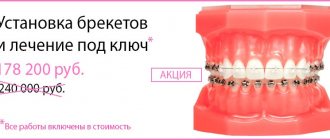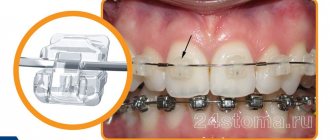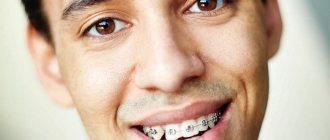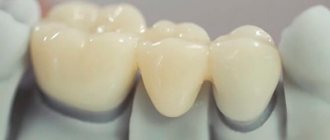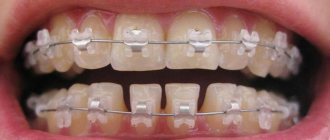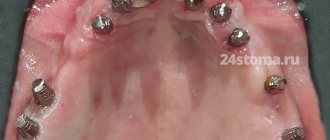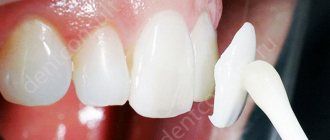Braces, or more precisely, braces systems, are structures that are used in dentistry to correct malocclusion and incorrect position of teeth. Braces are attached directly to the surface of the teeth and gradually lead to their displacement in a given direction. To date, this is the most effective method of orthodontic treatment. Unlike the same aligners, it is successfully used even in very complex cases.
- Indications for installing braces
- How do braces work?
- How is the treatment carried out?
- Types and composition of bracket systems
- Which braces are better?
- How long should you wear braces?
- Video of braces installation
- “Before and after” photos - correcting a bite using braces
- Doctors at the Novita clinic selecting and installing braces
- Prices for services for selection and installation of braces
- Sign up for a consultation
Indications for installing braces
Braces are used to correct abnormal bites and correct the position of teeth in the dentition. Braces can only be used on permanent teeth, so in children this treatment is used only from a certain age.
Why is it necessary to correct the position of teeth? Many people put aesthetics first - a beautiful smile and straight teeth make a person confident. However, dentists look at the problem from a different angle and put the functioning of the dental system first.
With a physiological occlusion, the teeth experience an even load during chewing, which ensures optimal functioning of the dental system. If there is a pathological arrangement of teeth, the load is distributed unevenly. Some teeth are overloaded, their enamel wears off more, and periodontal problems arise. All together this leads to tooth decay. In some cases it has to be removed. Prosthetics in this case can be problematic, due to the fact that it is not possible to achieve occlusion (closing) of the teeth.
On the other hand, teeth that do not receive the necessary load also suffer, no matter how paradoxical it may sound. Their blood supply deteriorates, which leads to the development of caries and periodontal problems.
Uneven loads also affect the temporomandibular joint. First, its dysfunction occurs, and then arthrosis. Ultimately, all this leads to the development of pain, the inability to open the mouth and make chewing movements.
Pros of braces
Despite the disadvantages of braces, this method of bite correction has significant advantages. These include:
- relatively short treatment time: braces quickly move teeth into the desired position, especially if we are talking about simple metal structures;
- a wide range of indications: many methods can be used only for mild malocclusions, while braces can be used in almost all cases of pathologies that do not require surgical intervention;
- compatibility with other methods: braces can act as an independent method of correction and complement other methods.
How do braces work?
The bracket system consists of two components:
- An orthodontic arch that has shape memory.
- Fastening mechanisms that combine the arch and brackets into a single system. These mechanisms come in two types - ligature and non-ligature. We'll talk about them a little later.
The main element in the design is the orthodontic arch, which is given a specific shape (it is unique for each patient). The archwire is attached to braces that are pre-installed on each tooth. It will strive to take the given shape and will inevitably “pull its teeth along with it” in the right direction.
As the teeth shift, certain processes will occur in the bone tissue of the jaw. On the side where the tooth is displaced, bone resorption will occur (it will not dissolve), and vice versa, a new one will grow on the opposite side.
There are situations when the arch force is not enough and it cannot provide adequate displacement of the teeth. Then they resort to additional devices, for example, elastic chains or drop-down springs. They increase pressure on the teeth and provide correction of their position.
Features of non-ligature braces
The fastening of the power arc in this type of design is carried out using miniature locks or clips with grooves glued to the bracket plates. The arc is inserted into the grooves and snaps into place. The absence of blocking allows the arc to move freely in the grooves. This significantly reduces the feeling of discomfort when wearing. The forceful effect occurs naturally; the system itself ligates the process, which is why it is also called self-ligating.
How is the treatment carried out?
Correcting the bite and straightening the teeth –
a complex and lengthy process that takes place in several stages:
- Diagnosis – a comprehensive dental examination is necessary. First, it is necessary to determine the correction method. Secondly, you need to make sure that there are no contraindications to orthodontic treatment. The patient's dentofacial system must withstand the load associated with tooth movement. For this purpose, all existing carious lesions are sanitized and, if necessary, treatment of paro- and periodontal tissues is carried out.
- The preparatory stage is the actual planning of orthodontic treatment. Based on the data obtained during the examination, calculations are made of models of the patient’s dental system, as well as calculations of an orthopantomogram and teleroentgenogram of the head in a lateral projection, and based on this, a treatment plan is drawn up.
- Installation of braces. First, the surface of the teeth is prepared. For this purpose, professional oral hygiene is performed, the enamel is dried, etched, washed and dried again. Only after this, adhesive (glue) compounds are applied and braces are installed. To make the glue work, it is polymerized using a lamp. The process of installing braces is presented in the video.
- Installation of an orthodontic arch. The duration and complexity of this process will depend on the method of attaching the braces. Ligature systems require more painstaking work than the use of non-ligature braces.
- Next, the patient must periodically visit the dentist to activate the arch. As the teeth move, the originally set arch shape will become irrelevant, so it must be periodically changed to a new one. The duration of wearing one arch is determined by the position of the teeth and the age of the patient. In young people, treatment is faster.
- Removal of braces and retention period. Once the teeth are in the desired position, the braces are removed. However, this is not the end of treatment. The fact is that the teeth will tend to take their original position, and to prevent this it is necessary to use supporting structures called retainers. In some cases, retainers will need to be used for life, in others - for several months or years after the braces are removed.
Models of braces in the Damon line
Damon Clear is just one type of Damon braces, there are others. Today, the line of Damon braces includes only 4 types:
Damon Q
Diamond Q braces are classic vestibular non-ligature braces. This type of braces is made of metal. Damon Q differs from other classic systems in its reduced size of locks, compactness, and strength. These braces allow you to achieve results even in the most difficult cases. Among the entire Damon line, this type of braces is the most affordable.
Damon 3 MX
This bracket system is self-ligating and is particularly durable. The strength of the structure is determined by its manufacture from steel.
Damon 3
It is a combined bracket system. Combines such qualities as reliability, functionality and aesthetics. Aesthetics are achieved through the use of special ceramic inserts that are practically invisible.
Damon Clear
The most expensive, but also the most innovative braces in the Damon line.
They are highly aesthetic. They are completely transparent, which makes them invisible on the teeth. It is Damon Clear braces that are discussed in this article. A distinctive feature of Damon bracket systems is the ability to use them in particularly difficult cases. If there are serious defects in the teeth, they usually have to be removed before installing standard braces. Damon systems allow you to save teeth and often only separation can be done.
Types and composition of bracket systems
Modern orthodontics has several types of braces in its arsenal. They may differ in design features, method of attaching the orthodontic arch and material of manufacture.
Depending on the method of fastening the arch, ligature and non-ligature systems are distinguished. Ligature systems are evolutionarily earlier. Here the arch is attached to the braces using ligatures, which have the form of rubber bands, wires, plastic rings, etc. This fastening reliably fixes the arch, which determines its complete immobility relative to the bracket. One of the advantages of this design is its relatively low cost. The disadvantages are the laboriousness of treatment - you need to frequently visit a doctor to activate the arc, and the process itself takes quite a lot of time. In addition, the ligature partially compensates for the force of the arc, which leads to an increase in the wearing time of the structure and difficulty in predicting the outcome of treatment.
In non-ligature systems, the arch is attached to the bracket using a special lock. This method of fastening facilitates the installation and activation of the arch and helps to ensure the displacement of teeth due to the action of weaker forces, i.e., the treatment occurs more physiologically. Non-ligating braces are also called self-ligating, and there are two ligation methods - active and passive. Active ligation involves a lock structure in which the arc is actively directed towards the groove. With passive ligation, the lock does not put pressure on the archwire and does not press it against the bracket. In other words, the arc can move relative to the groove to a certain extent. This makes the entire structure more physiological and makes it possible to better predict the result. Today it is considered the most progressive braces system.
Braces are also classified depending on where they are attached to the teeth. There are vestibular and lingual braces. Vestibular ones are attached to the front surface of dental crowns. Of course, they are noticeable to others, but at the same time they are easier to work with, they provide high predictability of treatment and are cheaper than lingual analogues.
Lingual braces are respectively attached to the lingual side of dental crowns. They are absolutely invisible to others, therefore they have high aesthetic characteristics. At the same time, there are a number of significant disadvantages - the volume of the oral cavity decreases, the design interferes with the tongue, rubs it, diction is impaired, and there are difficulties with chewing food. Such designs cannot be used for certain malocclusions and tooth alignment. In addition, such systems are expensive.
Braces are also classified according to the material they are made of:
- Metal braces are a classic of the genre. They are reliable and affordable.
- Plastic braces. The color is similar to tooth enamel, therefore they are more aesthetically pleasing than metal ones. But at the same time, they are more fragile and may not withstand the application of large forces, so the period of wearing the system increases. The advantages of plastic braces: they are more aesthetically pleasing, affordable, and quite convenient to use (less damaging to soft tissues). The disadvantages are fragility, duration of treatment, tendency to stain with food coloring.
- Ceramic braces. In terms of their aesthetic properties, they are as close as possible to tooth enamel, therefore they have high aesthetic characteristics. The material is more durable than plastic, but they are also more expensive.
- Sapphire braces are absolutely transparent and invisible on the teeth (as far as possible). Fragile, reliable, not painted with dyes, but expensive. Hard to remove
Metal braces in Moscow - the most common braces system price
Metal braces photo
Even though metal braces on teeth often cause skepticism, this does not prevent the rapid growth of their demand. You can get dental braces in Moscow in almost every dental clinic, but not everywhere you will be offered a decent quality design. Most often, metal braces are installed on teenage patients. The products are distinguished by their reliability, functionality, and efficiency. Our dentists will offer you an impressive selection of dental braces systems - from proven classics to designs with colored elements. Expensive gold braces, known for their grace and elegance, are also very popular.
Which braces are better?
It is impossible to answer this question unambiguously. The choice of system is determined by the condition of the patient’s dentofacial system and his financial capabilities. The most powerful and reliable systems are vestibular metal ligature braces. This is a powerful tool for non-surgical treatment in orthodontics. With the help of such designs, the most complex problems are corrected. A significant advantage is the lowest cost. Their result and the effectiveness of such treatment can be assessed from the photo.
Ligature-free braces look more aesthetically pleasing and are softer, so they can be used for periodontal problems.
Aesthetic options for braces involve the use of materials that would be invisible against the background of tooth enamel. But the other part of the structure, the orthodontic arch, is still noticeable. Of course, there are options when it is coated with white Teflon, but this coating is unreliable and can partially peel off, then the arc will become striped. In terms of reliability, aesthetic braces are more fragile. They may break or come off.
What to choose? Decide for yourself based on the dentist’s recommendations, the characteristics of your clinical case and financial capabilities.
Advantages of ligature and non-ligature constructions
Each type of correction system has a whole list of undeniable advantages.
Pros of ligature braces:
- effective in correcting even the most complex defects;
- availability of treatment for patients of any age;
- affordability.
Advantages of self-ligating braces:
- aesthetic appearance, especially for ceramic structures;
- short adaptation period (about 2 weeks). Note: the duration of addiction depends on the individual characteristics of the patient;
- less frequent visits to the clinic to set up equipment (approximately once every 2 months);
- Possibility of use for periodontal disease;
- minimizing the risk of injury to the mucous membranes of the lips and cheeks;
- Easy to install and remove.
How long should you wear braces?
This question is also individual and depends on the existing problem and the age of the patient. The younger the person, the shorter the period of wearing the system. In children and adults, the average treatment period is 18 months.
It is also necessary to take into account that after removing braces, orthodontic treatment does not end. The position of the teeth still remains unstable due to the characteristics of the osseous-ligamentous apparatus of the jaw. If the teeth are not fixed, they will tend to return to their original position, which will lead to relapse. Therefore, additional fixation is required.
For this purpose, retainers and retention mouthguards are used on the upper and lower jaws. Mouthguards are worn for several hours a day, for example, while sleeping. Fixed retainers have the form of an arch, which is attached to the vestibular surface of the teeth using special adhesive materials. It is impossible to remove it yourself. The retention time is determined individually. In most cases, it is twice as long as you wear braces. However, for some patients, retention is indicated for life.
Dental health depends not only on timely diagnosis and treatment of carious lesions, but also on the overall development and well-being of the dental system, including periodontal condition, bite and other factors. Therefore, correcting the bite and straightening the teeth using vestibular braces is not limited to purely aesthetic purposes, but is also designed to preserve the health of your teeth and the entire oral cavity for as long as possible! And due to the close relationship of all body systems, healthy teeth and correct bite will be the key to normalizing the functioning of the gastrointestinal tract.
In our clinic we use brace systems from different manufacturers, but the best, in the opinion of our orthodontist, are the Experience series braces (GC Orthodontics, Japan) - the world leader among interactive non-ligature systems. Today, Experience is manufactured at the Japanese plant of TOMY Inc., which has been developing and manufacturing high-quality orthodontic systems since 1959 and is the owner of the Japan Quality Medal, the highest award for quality control in the world.
Factors influencing the choice of type of braces
Dentists have identified the most significant factors that can influence the choice of braces. Among them:
- specifics of malocclusion;
- the fact that there is a need to remove certain elements of the dentition;
- the need for surgical intervention;
- patient's financial capabilities;
- personal preferences regarding the aesthetics of braces;
Once the patient has decided on the above criteria, the dentists at our Aesthetica clinic will offer him a variety of suitable braces. A wide range allows you to choose the optimal design of dental braces even for particularly problematic cases.
Damon Clear braces in Krasnodar
Damon Clear braces are gaining more and more popularity in dentistry around the world. Also in our dentistry in Krasnodar “Symmetry”, our patients often choose this type of braces.
The benefits of Damon Clear are obvious and have been mentioned many times in this material. The only downside may be the slightly higher price compared to other braces. But the cost is offset by a huge number of advantages that cannot be achieved by using cheaper analogues.
At our Symmetry dentistry, orthodontists have extensive experience in installing the Damon-Clear braces system. This system has been used several times in the treatment of our patients and they all spoke very positively about it.
You can find out the cost of orthopedic treatment or make an appointment directly on our website. We are waiting for you at our clinic. Our doctors will make your smile dazzlingly beautiful!
Pros and cons of ceramic braces
The positive aspects of installing ceramic braces include:
- maximum proximity of the shade of the structure to the natural color of the enamel;
- absence of hypersensitivity and allergic reactions to the material;
- the shape and smooth surface of the braces avoids mechanical trauma to the mucous membrane and soft tissues;
- good resistance to food dyes, due to which the natural shade is preserved for a long time;
- optimal pricing policy.
Like any medical procedure, installing this design has its disadvantages, which include the following points:
- in some clinical cases, the dentist may recommend installing braces made of a different material, since there are more durable options;
- the period of use of ceramic braces to achieve the final therapeutic result is three to four months longer than that of other types of construction, however, the duration of this period is determined by the attending physician, taking into account the individual characteristics of the body;
- increased requirements for oral care and nutrition.
Each patient decides for himself whether this type of design is suitable for him, but the deliberation process should be based on the recommendations of the doctor, who expresses a professional opinion based on the data obtained about the patient’s health condition.
What material for braces should I choose?
Modern braces systems can be not just functional, they can be aesthetic, stylish, bright or transparent. This is possible thanks to the use of materials with different properties: plastic, ceramics, sapphire, simple or precious metal
. The properties of the listed materials are different; the choice of a specific one depends on the age of the patient, his preferences regarding aesthetics and structural strength, as well as financial possibilities.
| ceramics | metal | sapphire |
If you need a quick and inexpensive correction, you can opt for a metal structure; if long-term correction is expected, and the patient’s lifestyle requires publicity, it is worth considering ceramic or sapphire braces.
Caring for ligature braces
As we have already indicated above, ligature braces require more careful care. All additional elements in the mouth prevent the free passage of the toothbrush during brushing. Ligatures are precisely these elements that interfere with hygiene. Rubber bands collect food debris and accumulate plaque. To thoroughly clean the lock, the ligature must be removed, but the patient does not have this option.
Therefore, hygiene must be maintained with available tools:
- Orthodontic brush with a special groove in the middle for braces
- A mono-beam brush that allows you to clean the lock around, the gingival area and the enamel under the arch.
- Orthodontic brushes are small brushes for hard-to-reach places - under the arch, in tooth spaces, around distant braces.
- An irrigator is a device that cleans surfaces and hard-to-reach places using a powerful jet of water. This is a hygiene instrument that is safe for mucous membranes and effective against food residues.
Complete care during treatment with braces is selected by an orthodontist or a hygienist. At the Confidence clinic you receive a detailed instruction manual on how to care for braces and can visit a hygienist at any time. He will point out mistakes in care and suggest the correct algorithm and home cleaning products.
Advantages of the Damon Clear braces system
As mentioned earlier in this article, Damon Clear is an excellent braces system that has many advantages over other braces. Some of the benefits have been described earlier in this article. They and other advantages will be discussed in more detail below. So, the main advantages of Damon Clear include:
High aesthetic appeal.
The bracket system is made of a special, invisible ceramic material. Throughout the entire period of use, this type of braces retains its attractiveness and does not change its color. It is also necessary to note once again that Damon Clear is a ligature-free system. The absence of ligatures has a positive effect on aesthetics.
Durability and reliability.
Using such braces, you will protect yourself from the risk of breakage, and, consequently, from additional repair costs and visits to the dentist. Damon Clear is an exceptionally high-quality system made from highly reliable ceramic materials.
Comfort.
The braces have a rounded shape, which causes almost no discomfort. After installing such a brace system, getting used to it happens quickly and unnoticeably. Oral hygiene also does not cause any inconvenience, which cannot be said about other ligature systems.
No injury.
Damon Clear, as noted above, has excellent manufacturing quality with carefully measured force on the tissues of the oral cavity. This eliminates any significant traumatic load.
Fast treatment process.
After installing braces, you need to undergo a follow-up examination only once every two months. The entire process of correcting malocclusion takes an average of 14 to 18 months, which is approximately 30% less than when using other braces.
How are clear sapphire braces made?
Thanks to the development of technology, scientists have learned to quickly grow crystals in laboratory conditions with given physical characteristics, similar to natural crystals that have been growing for thousands of years. Artificially grown minerals found application first in jewelry (colored sapphires) and in the watch industry, and then in orthodontics (perfectly transparent colorless sapphires).
- In terms of hardness, sapphire locks are second only to diamond, and in terms of aesthetics they are quite comparable to it, since they have the appropriate coefficients of reflection and refraction of light.
- When in contact with saliva, they completely merge with the teeth.
- The special cut of the crystals makes sapphire braces a stylish dental decoration and at the same time minimizes the likelihood of injury to the soft tissues of the oral cavity.
- Due to their minimal thickness, they do not cause the unpleasant sensation of protruding lips.
- In the rays of neon lighting of nightclubs, artificial sapphire does not glow and therefore does not catch the eye at all.
Pros, cons and nuances of bite correction using braces and aligners
Today, braces remain the most effective method for correcting almost any malocclusion pathology (except for cases where treatment requires maxillofacial surgery). In terms of application possibilities, aligners are inferior to braces, but every year the indications for their use are expanding.
The undoubted advantage of aligners is their invisibility to others, the comfort of treatment and the predictability of the result (even before the start of treatment, the patient knows exactly what position the teeth will take and how long it will take).
While undergoing treatment with aligners, you don’t have to limit yourself to food: take off the mouthguard and eat! And daily hygiene is not a problem, it’s just important not to forget to brush your teeth after every meal, but with braces everything is not so simple.
Correcting a bite using aligners is pleasing with a clear calculation of the treatment time, because the number of manufactured trays, each of which must be worn for 2 weeks (22 hours a day), determines with an accuracy of the day when the teeth will take the correct position.
Today we have shared with you very important information that will help you make an informed decision.
Who is recommended for turnkey installation of sapphire braces?
The aesthetic design is recommended for patients with minor dental defects:
- with a pathological bite;
- with uneven dentition and teeth rotated around an axis;
- with too large interdental spaces;
- if you are allergic to metal alloys used in dentistry;
- if necessary, improve facial aesthetics.
Treatment with sapphire braces is prescribed by a doctor only after a thorough preliminary diagnosis and identification of the cause of the anomaly.
In addition, the transparent orthodontic design looks its best only on white teeth. On enamel that is yellowish or has a grayish tint, transparent locks will be quite noticeable. Many patients hope to have their teeth whitened before getting braces. But such a procedure weakens tooth enamel, which can already be damaged while wearing the system, so it is not worth carrying out.
In the orthodontist’s office, you can “try” both sapphire and ceramic clasps on your teeth to choose the least noticeable ones.

